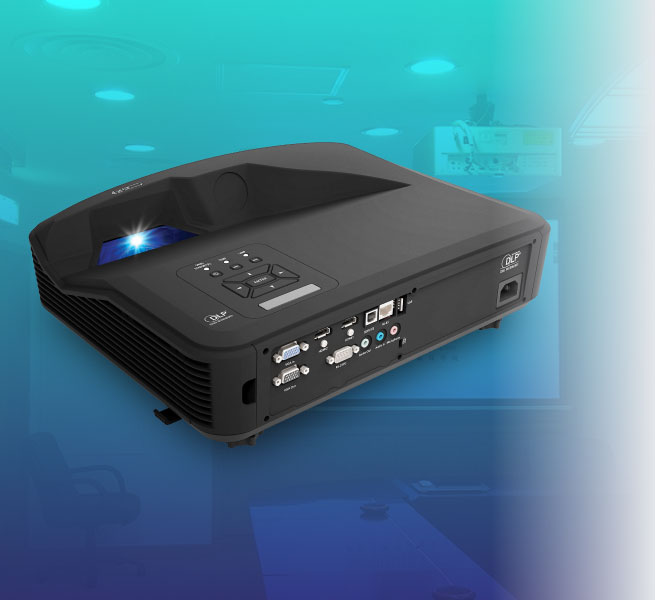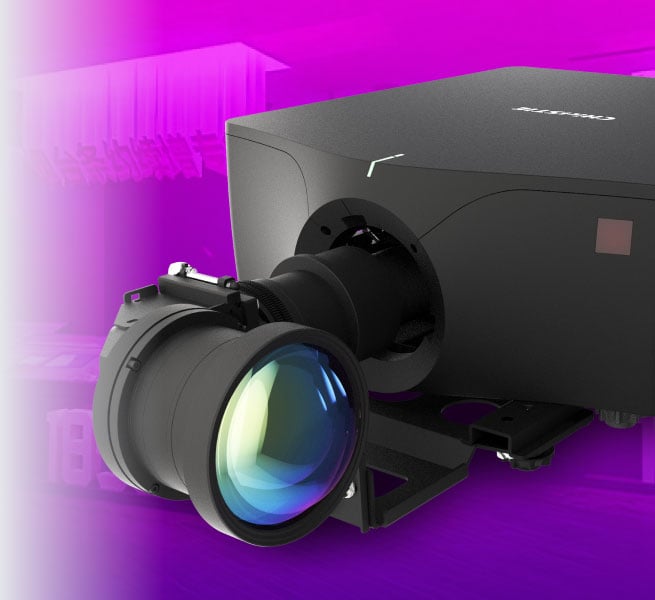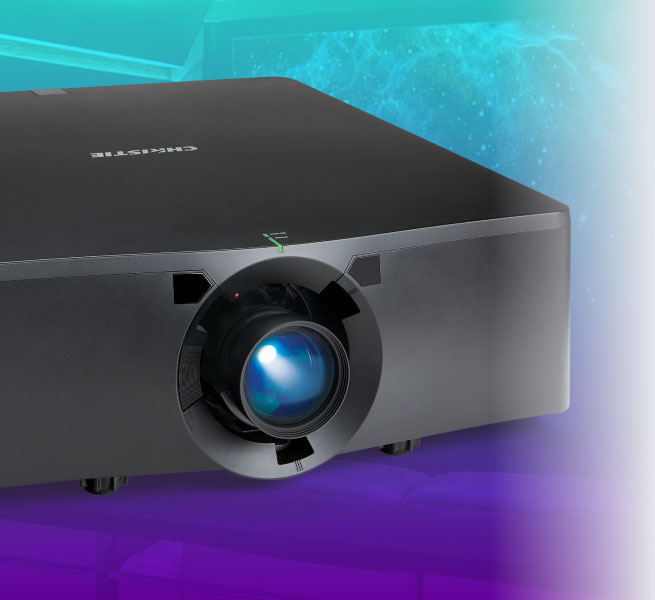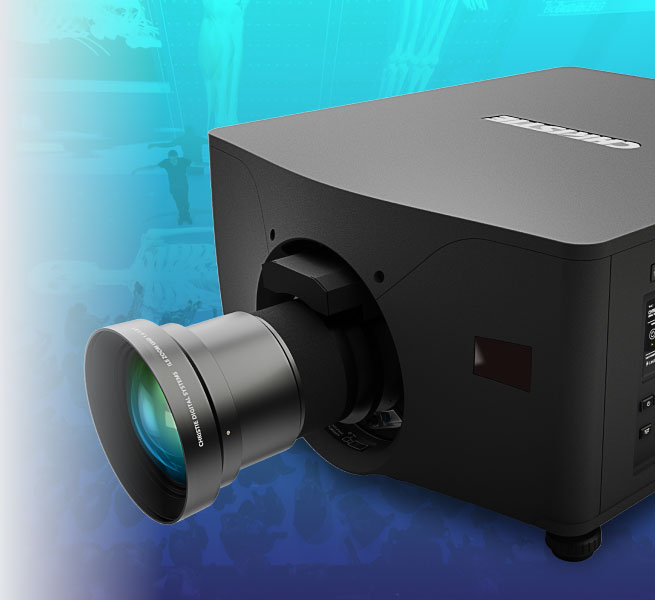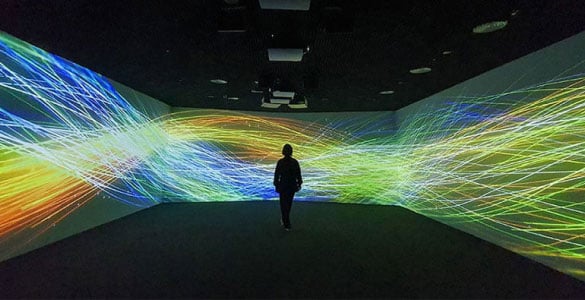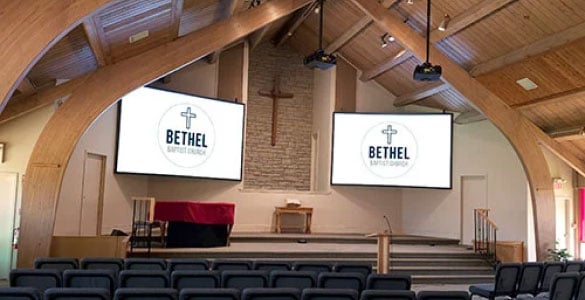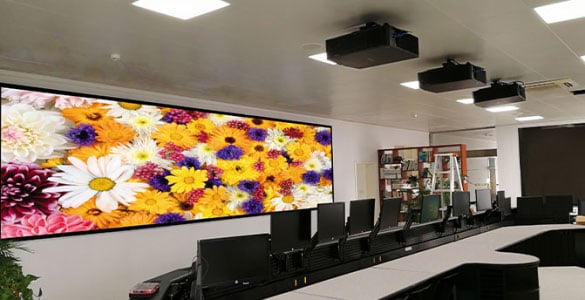What is an ultra short throw projector?
An ultra short throw (UST) projector is designed to project an image onto a screen or wall from a shorter distance than standard throw projectors. Ultra short throw projectors are usually set or mounted very close to the screen. An ultra short throw projector has a throw ratio between 0.25-0.5:1. To calculate the specific throw ratio needed for your application, use our lens calculator.
How does a laser phosphor projector work?
Laser phosphor projectors use blue laser diodes as their primary light source, which shine onto a spinning yellow phosphor wheel. The light emitted from the wheel is separated into red and green, while the blue light passes directly through a segment in the wheel. Advanced laser phosphor projectors use a direct red laser diode to boost the low output of red and produce better overall saturation and realistic color.
What’s the difference between a short throw projector and an ultra short throw projector?
A short throw projector (ST) is designed to project an image onto a screen or wall from a short distance, but from further away than an ultra short throw projector. Short throw projectors have a throw ratio between 0.5-1:1, while UST projectors have a throw ratio between 0.25-0.5:1. To calculate the specific throw ratio needed for your application, use our lens calculator.
How do ultra short throw projectors work?
Ultra short throw projectors work by using L-shaped lenses using mirrors and advanced optical technology to project large images from very short distances. The innovative design allows for flexible placement options in small spaces, making them a versatile choice for many applications. UST projectors can be positioned much closer to the screen compared to a standard throw projector, which saves space and almost eliminates the risk of casting shadows on the screen.
How do ST projectors work?
Short throw projectors use traditional straight lenses with the capability of projecting a wide image from a short distance while reducing shadows.
What are the benefits of using UST projectors over standard projectors?
In applications where rear projection isn’t possible, a UST projector is a great choice. UST lenses are designed to reduce shadows, making them suitable for environments where people may need to interact with the projected image or where space is limited.
Do I need a screen for a short throw projector?
Typically, screens are used for projection, but there are applications and installations where content can be projected directly onto a wall or other surfaces such as buildings or 3D objects.
Can a short throw projector support 3D projection, and what are the considerations for choosing a short throw 3D projector?
Yes, by using several together, short throw projectors can support 3D applications. When choosing a short throw 3D projector, consider factors such as the projector's compatibility with 3D content, the throw ratio, and the availability of 3D glasses.
Do short throw projectors work in well-lit environments? How bright does my projector need to be?
Both short throw and ultra short throw projectors can work in well-lit environments. Like standard throw projectors, the most important factor is the projector's brightness specifications: Projectors with a higher lumen count will work better in well-lit environments. The requirements depend on your specific installation environment.
Can I mount my projector on a ceiling or wall?
You can mount a short throw and ultra short throw projector with a standard ceiling mount. However, the Captiva DWU500S is a specialized ultra short throw projector (UST) that is designed to be wall mounted.
Can you use a ST/UST projector in portrait mode?
Short throw and ultra short throw projectors can both be used in portrait mode. When mounting a projector in portrait mode, it's important to consider a possible lens offset to ensure that the projected image is in the right location for the projection surface.
Can I increase the size of a projected image with a fixed lens?
Fixed lenses don't allow for the image to be zoomed smaller or larger. When using a fixed lens, the only way to control the image size is by changing the projector distance from the screen or projection surface. Manufacturers will typically recommend a maximum screen size for ideal image quality.
How do I choose the right projector for my project?
The projector and lens you need vary depending on your installation requirements. To find the right projector and lens for your project, check out the Christie Projector selection guide
How is the color performance of RGB pure laser projectors different from laser phosphor projectors?
The right lens for your projector varies depending on the projector you’re using and your installation requirements. To choose the right lens for your projector, use our projector lens calculator.
